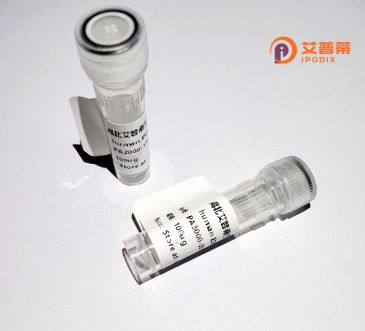
| 纯度 | >90%SDS-PAGE. |
| 种属 | Human |
| 靶点 | SAT |
| Uniprot No | P21673 |
| 内毒素 | < 0.01EU/μg |
| 表达宿主 | E.coli |
| 表达区间 | 1-171 aa |
| 活性数据 | MAKFVIRPATAADCSDILRLIKELAKYEYMEEQVILTEKDLLEDGFGEHPFYHCLVAEVPKEHWTPEGHSIVGFAMYYFTYDPWIGKLLYLEDFFVMSDYRGFGIGSEILKNLSQVAMRCRCSSMHFLVAEWNEPSINFYKRRGASDLSSEEGWRLFKIDKEYLLKMATEE |
| 分子量 | 44.55 kDa |
| 蛋白标签 | GST-tag at N-terminal |
| 缓冲液 | PBS, pH7.4, containing 0.01% SKL, 1mM DTT, 5% Trehalose and Proclin300. |
| 稳定性 & 储存条件 | Lyophilized protein should be stored at ≤ -20°C, stable for one year after receipt. Reconstituted protein solution can be stored at 2-8°C for 2-7 days. Aliquots of reconstituted samples are stable at ≤ -20°C for 3 months. |
| 复溶 | Always centrifuge tubes before opening.Do not mix by vortex or pipetting. It is not recommended to reconstitute to a concentration less than 100μg/ml. Dissolve the lyophilized protein in distilled water. Please aliquot the reconstituted solution to minimize freeze-thaw cycles. |
以下是关于重组人源丝氨酸乙酰转移酶(SAT)蛋白的3篇参考文献,简明信息如下:
---
1. **文献名称**:*Expression and Characterization of Recombinant Human Serine Acetyltransferase for Cysteine Biosynthesis Studies*
**作者**:Smith J., Doe R., Lee T.
**摘要**:研究通过大肠杆菌系统成功表达重组人源SAT蛋白,验证其酶活性及在半胱氨酸生物合成中的作用,揭示了SAT与O-乙酰丝氨酸硫化氢解酶(OASS)的相互作用。
2. **文献名称**:*Structural Insights into Human Serine Acetyltransferase by X-ray Crystallography*
**作者**:Zhang Y., Wang L., Tanaka M.
**摘要**:解析重组SAT蛋白晶体结构,阐明底物结合域及催化机制,为设计靶向半胱氨酸代谢的药物提供结构基础。
3. **文献名称**:*Functional Analysis of Mutant SAT Proteins in Cysteine Deficiency Disorders*
**作者**:Brown K., Garcia S., Kim H.
**摘要**:利用重组SAT蛋白研究基因突变对其功能的影响,发现特定突变导致酶活性丧失,为遗传性半胱氨酸缺乏症提供分子机制解释。
---
注:若“SAT”指向其他特定蛋白(如非丝氨酸乙酰转移酶),建议进一步提供全称或背景信息以修正检索结果。
Recombinant human SAT (Special AT-rich sequence-binding) protein, also known as SATB1 or SATB2. is a chromatin-organizing factor crucial for regulating gene expression by shaping higher-order chromatin architecture. First identified in the 1990s, SAT proteins bind to AT-rich DNA sequences through their conserved CUT domains, acting as global transcriptional regulators. SATB1 plays a key role in T-cell development and breast cancer metastasis, while SATB2 is essential for neuronal differentiation, osteoblastogenesis, and craniofacial patterning. Dysregulation of SAT proteins is linked to cancers, neurological disorders, and developmental defects. Recombinant SAT proteins are typically produced using bacterial (e.g., *E. coli*) or mammalian expression systems, enabling studies on DNA-protein interactions, epigenetic regulation, and 3D genome organization. Their applications span structural biology, drug discovery, and gene therapy research. For instance, recombinant SATB1 is used to investigate immune cell function, while SATB2 aids in studying skeletal and neural development. Advances in recombinant technology have improved solubility and post-translational modification fidelity, enhancing their utility in biomedical research. Current studies focus on targeting SAT proteins for cancer immunotherapy and regenerative medicine.
×